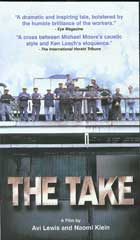
The Take 2003
Distributed by First Run/Icarus Films, 32 Court St., 21st Floor, Brooklyn, NY 11201; 800-876-1710
Produced by Barna-Alper Productions with National Film Board of Canada
Directed by Avi Lewis and Naomi Klein
VHS, color, 87 min.
Sr. High - Adult
Latin American Studies, Labor Relations, Globalization
Date Entered: 11/12/2004
Reviewed by Veronica Maher, Roger Williams University, Bristol, Rhode IslandOne of this year’s entries in the American Film Institute’s Los Angeles Film Festival this is a documentary worth viewing. Written and directed by social activists Naomi Klein and Avi Lewis, self-proclaimed “unabashed leftists in the corporate media” this inspiring film focuses on the efforts of a group of workers in Argentina who want to get back to work. They align themselves with the National Movement of Recovered Factories to try to not only occupy their factory but to gain back their dignity. The failed economic policy of Argentina, mandated by the global corporate policies of the IMF and World Bank, and exacerbated by the bank withdrawals of millions of dollars by multinational companies is seen to be the root cause of the abandoned factories throughout Argentina. The filmmakers follow the workers through their ordeal revealing a deep emotional toll on the participants. In a tour of one abandoned factory, a worker notes that even the pigeons are gone. The goal of this featured group, the Forja San Martin, is to achieve expropriation since the owner had abandoned the factory owing back wages. They seek advice and pursue a legal course to sustain their occupation. They look to the success of the Zanon and Brukman workers for their inspiration.
The background of all this is, of course, the crisis in the political and economic programs in Argentina between 1998 and 2001, and the “movimiento de fabricas recuperadas” which is challenging the capitalistic system in Argentina. In this lengthy, 87 minute production, actual footage, film clips and interviews inform us of the disparities of circumstances. A combination of narration and interviews (subtitled), film clips and actual footage of the events give the viewer a good sense of what is going on here. Too long for most one class viewings, this can be used for Latin American studies, labor studies, economics and globalization. Highly recommended.